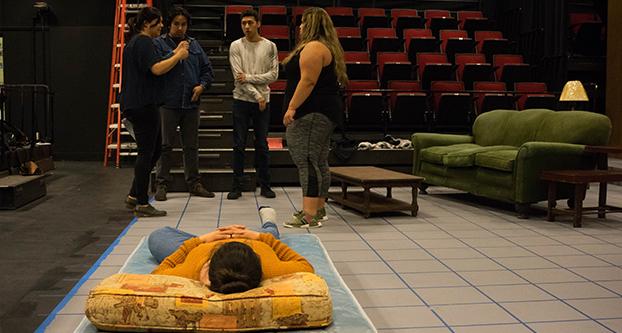Kenia Morales lies still on a bare mattress on the floor of the Dennis and Cheryl Woods Theatre. She breathes deeply and opens her eyes, with a look of shock on her face.
“She touched me and I flew. Touched my fault line. And I flew,” she said.
Morales is rehearsing her role as Ceci in Fresno State’s University Theatre production of “Lydia” by Octavio Solis. The play’s opening night will be March 16 at 7:30 p.m.
Students in the production rehearsed the play alongside their director and recent addition to the theatre arts department, Latinx theatre professor Gina SandÃ-DÃaz.
“Lydia” follows a family living in El Paso, Texas, in the early 1970s after Ceci, the middle child, is left in a vegetative state following an accident. The family hires Lydia, an immigrant from Jalisco, Mexico, to come and look after Ceci.
“It’s a story about scapegoating as much as it is a story about love, and how do we deal with the impositions of society and how those impositions affect who we want to become in our lives,” SandÃ-DÃaz said.
The play is a coming-of-age tale with layered and complex young characters driving the story. Blending of generations and cultures come into play, as well, with the inclusion of the parents in the play and the different background Lydia has from the other characters as an immigrant.
According to SandÃ-DÃaz, one of the main themes presented is identity and how the characters see themselves in relation to themselves and the world.
“Some of these characters are struggling, really struggling,” SandÃ-DÃaz said. “They want to be American. They want to be read as American, and they tend to not accept, or not be too open to, their Mexican heritage.”
While some characters struggle with that part of their identity, others welcome that part of their background. Another theme, according to SandÃ-DÃaz, is being an “other” in a foreign society and how to understand what that means.
“We’re seeing a story that is happening in 1970, and here we are in 2018, and we haven’t resolved those issues,” SandÃ-DÃaz said. “We’re still talking about what it means to be an ‘other.’ We’re still talking about immigration and immigration laws. We’re still dealing with all of this.”
The subjects discussed in the work are what students involved in the production enjoy about “Lydia.”
“I really like the fact that this play speaks for us. Speak for what makes us not just Mexicans in the [U.S.], but Latinos in the [U.S.] in general,” said Dalicia Torrecillas, who plays Rosa, the mother.
Gina SandÃ-DÃaz and Latinx theatre
“Lydia” is just one play in the vast genre that is Latinx theatre, a genre that is SandÃ-DÃaz’s specialty.
“We call it ‘Latinx’ because we’re trying to be inclusive of the many intersected identities,” she said. “So we’re not just talking about gender. We’re not just talking about male and female. We’re talking about any intersected identity in between that feels that they can be a part of this movement.”
SandÃ-DÃaz, like many of the students in her classes and involved with the play, has a number of intersecting identities with which she identifies.
She is from Costa Rica, where she attended the Universidad Nacional de Costa Rica and developed her career in performing arts. She then studied in Kansas and afterward came to Fresno State to become the Latinx theatre professor.
“[Latinx theatre] is political by nature in the sense that it’s trying to help people develop their critical thinking and identify problems that are affecting their culture,” SandÃ-DÃaz said.
According to SandÃ-DÃaz, many students are connecting to the topics featured in works like “Lydia” and other works by writers in Latinx theatre covered in her classes.
“In class, I find that students are very engaged and that the materials that I have to offer directly speak to the life experiences of the students that live here,” SandÃ-DÃaz said. “I can see myself contributing to the community here, and I can see how my life experience connects to the life experience of the Central Valley.”
Those varied life experiences can ultimately be seen in the story of “Lydia.”
“All of these characters are three-dimensional,” SandÃ-DÃaz said. “They’re human beings who are trying to navigate who they are in the world, finding their place in the world and any human being can relate to that.”




